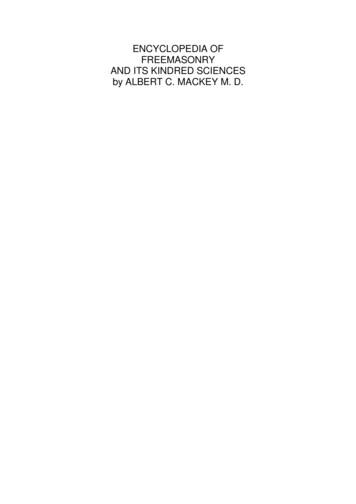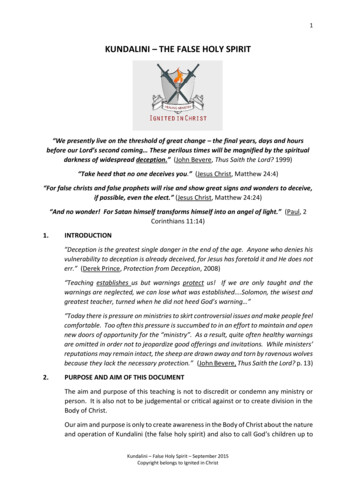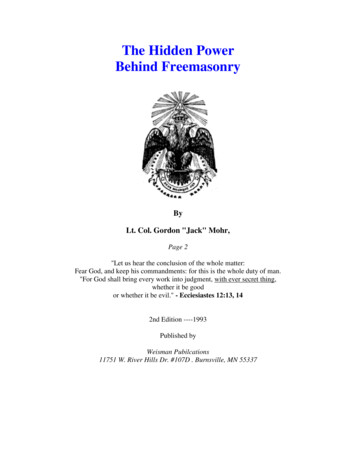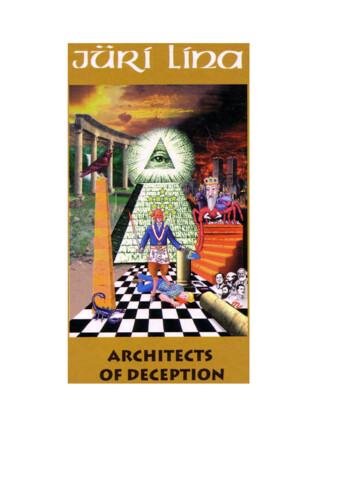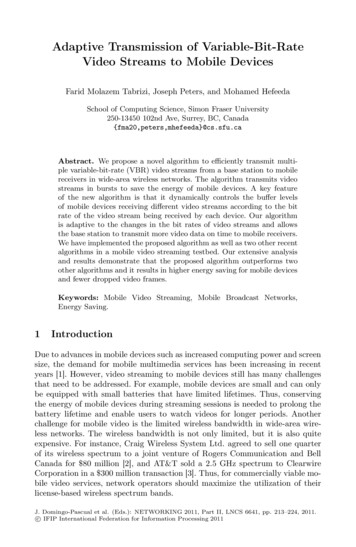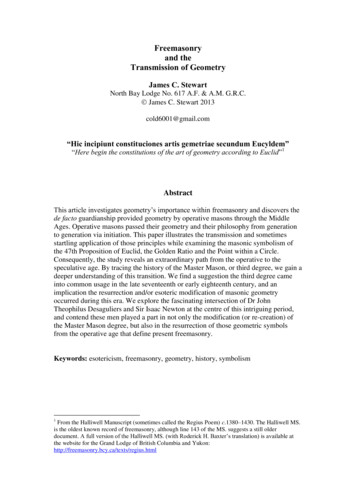
Transcription
Freemasonryand theTransmission of GeometryJames C. StewartNorth Bay Lodge No. 617 A.F. & A.M. G.R.C. James C. Stewart 2013cold6001@gmail.com“Hic incipiunt constituciones artis gemetriae secundum Eucyldem”“Here begin the constitutions of the art of geometry according to Euclid”1AbstractThis article investigates geometry’s importance within freemasonry and discovers thede facto guardianship provided geometry by operative masons through the MiddleAges. Operative masons passed their geometry and their philosophy from generationto generation via initiation. This paper illustrates the transmission and sometimesstartling application of those principles while examining the masonic symbolism ofthe 47th Proposition of Euclid, the Golden Ratio and the Point within a Circle.Consequently, the study reveals an extraordinary path from the operative to thespeculative age. By tracing the history of the Master Mason, or third degree, we gain adeeper understanding of this transition. We find a suggestion the third degree cameinto common usage in the late seventeenth or early eighteenth century, and animplication the resurrection and/or esoteric modification of masonic geometryoccurred during this era. We explore the fascinating intersection of Dr JohnTheophilus Desaguliers and Sir Isaac Newton at the centre of this intriguing period,and contend these men played a part in not only the modification (or re-creation) ofthe Master Mason degree, but also in the resurrection of those geometric symbolsfrom the operative age that define present freemasonry.Keywords: esotericism, freemasonry, geometry, history, symbolism1From the Halliwell Manuscript (sometimes called the Regius Poem) c.1380–1430. The Halliwell MS.is the oldest known record of freemasonry, although line 143 of the MS. suggests a still olderdocument. A full version of the Halliwell MS. (with Roderick H. Baxter’s translation) is available atthe website for the Grand Lodge of British Columbia and Yukon:http://freemasonry.bcy.ca/texts/regius.html
21. A brief history“Here begin the constitutions of the art of geometry according to Euclid.”The opening line of the Halliwell Manuscript, freemasonry’s oldest knowndocument, illustrates the significance of geometry within the craft. To this day, somesix hundred years later, when passed to the Fellowcraft, or second degree, thecandidate is taught masonry and geometry were “originally synonymous terms.”2The history of freemasonry is a controversial subject, but a shaky consensus 3finds its origins in the operative lodges and guilds of the Middle Ages,4 passed onthrough various ecclesiastical orders from the remnants of the Roman collegia.5 Itsfingerprints are found in the geometry of the great Gothic cathedrals of Europe, whilethe art of that geometry was kept a closely guarded secret6 that allowed those earlymasons economic, political and theological influence.It is important to consider the historical context of these operative brethren.There was no electricity, no running water. Books were available mostly for theprivileged and the church. Not that it mattered; few people knew how to read. Formuch of the medieval era operative masons became the de facto guardians ofgeometry, and consequently one source for its diffusion into modern times.7Much has been written concerning the history of geometry and its intriguingintersections with freemasonry. It’s worth pausing to examine a few of the morenotable examples establishing geometry as the foundation of the masonic system.In those handwritten documents surviving from the operative age, termed theOld Charges by masonic scholars, the prominence of geometry is made abundantlyclear. This is demonstrated first in the ancient Halliwell Manuscript and underscoredagain in the slightly later Matthew Cooke Manuscript (c.1430-50).8The Cooke Manuscript expands upon the importance of geometry to the craft,the document placing a particular emphasis on the art. In the manuscript, Pythagorasand Hermes bestow geometric knowledge on the human race9 and, in relation to the“seven liberal sciences,” it suggests all others owe their existence to the first:geometry.10Anderson’s Constitutions of 1723 continues this tradition into the speculativeage. In Anderson’s romantic, if not improbable view of masonic history, we findAdam, “our first parent”, having geometry inscribed upon his heart by the Great2The Work, The Grand Lodge of Canada in the Province of Ontario, 1999. This is the currentceremonial ritual of freemasons living in the province of Ontario, Canada. No author, publisher, editoror compiler is listed.3An example of the debate swirling around the so-called “transition theory” can be found in twoarticles on the website for the Grand Lodge of British Columbia and Yukon: “Transition Theory” by DrWallace McLeod: http://freemasonry.bcy.ca/history/transition.html and “The transition theory refuted”by C.N. Batham: tml4Paul Naudon, The Secret History of Freemasonry (Rochester, Vermont: Inner Traditions, 1991) p. 25Thomas Hope, An Historical Essay on Architecture Vol 1. (London: John Murray, 1840) pp. 205-2086Frederick Apthorp Paley, A Manual of Gothic Architecture (London: John Van Voorst, 1846) p. 787Matila Ghyka, The Geometry of Art & Life (New York: Dover Publications, 1977) pp. 117-1188A.E. Waite, A New Encyclopaedia of Freemasonry Combined edition, Vol. 1 (New York: RandomHouse, 1996) pp. 140-1419“The Matthew Cooke Manuscript with translation,” The Grand Lodge of British Columbia andYukon. Lines 320-326. http://freemasonry.bcy.ca/texts/cooke.html10Cooke MS., Lines 77-140
3Architect of the Universe.11 A bit of hyperbole, but it is illustrative of the weightgiven the subject by Enlightenment-era brethren.Geometry and the esoteric societies of past centuries seem to share a parallelhistory, perhaps owing in part to the art’s previously discussed architecturalapplications. This tradition stretches back to ancient Greece. One of the more alluringexpressions of early Greek religion is the existence of its mystery schools, accessibleonly through individual initiation and oaths of secrecy. The Greek word myesis meansinitiation, and the related word mystai refers to one who is an initiate.12Consider the priests of Dionysius or the legendary architect kings Trophonius,Dadaelus and Agamedes. The architects of this era maintained their priesthoodsthrough initiation. We know the Dionysiasts’ organization had a specific initiationritual, as well as words and signs by which they recognized one another.13And of course Pythagoras, one of geometry’s great explorers, also usedinitiation to enter apprentices into his school of philosophy and mathematics. ThePythagoreans treated silence and secrecy as cardinal principles and, in an interestingsynchronicity with modern freemasonry, the order had a series of three degrees.Pupils were divided into exoterici, or students of the outer grades, and esoterici, afterthey were accepted into the third.14The Pythagoreans were early monotheists and defined God numerically as theMonad or “One that is Everything”. They believed the universe is ordered by theMonad in a geometrically precise manner, a belief which was adopted as acornerstone of freemasonry.15 This resulted in one of the Church’s many conflictswith the craft. The Church was adamant the universe was ordered by faith, not bygeometry or reason.16Today, the Pythagoreans are best known for producing the theorem that bearstheir founder’s name, a theorem instrumental to the development of highermathematical concepts and intrinsic to the philosophy of freemasonry.2. The symbolic and sacred geometry of freemasonryAn examination of three geometric principles employed in the symbolism offreemasonry provides a window into history, and demonstrates the importance ofgeometry not just to the craft, but to modern civilization. The placement of thesesymbols in the masonic system allows us to draw some intriguing corollaries.11James Anderson, The Constitutions of the Free-Masons, Containing the History, Charges,Regulation & c. of That Most Ancient and Right Worshipful Fraternity (London: William Hunter,1723) pp. 1-2. A digital version can be found 2#page/n7/mode/2up12Janina K. Darling, Architecture of Greece (Westport, Connecticut: Greenwood Press, 2004) pp. 16516613Paul Naudon, The Secret History of Freemasonry, pp. 6-714Manly P. Hall, The Secret Teachings of All Ages (New York: Tarcher/Penguin, 2003) pp. 194-19515Manly P. Hall, The Secret Teachings, p. 19416Pope Pius IX, Encyclical of Pope Pius IX, Qui Pluribus “On Faith and Religion,” 9 November 1846.Paragraphs 4 to 7. m
42.1 Euclid’s 47th Proposition: a Pythagorean legacyFigure 1. The Pythagorean Theorem (the 47th Proposition): the square of thehypotenuse of a right-angled triangle is equal to the sum of the squares of the twoadjacent sides.The 47th Proposition is a symbol associated with freemasonry almost as frequently asthe iconic square and compasses. There is little point dwelling on the history of thisfamous theorem; the topic has been exhaustively studied. Suffice to say, the Greeksdid not express Pythagoras’ theorem as we know it today.In ancient times, the theorem was communicated verbally and geometrically. 17Around 250 BCE it obtained its secondary name, its first proof and a defined form asProposition 47 in Euclid’s celebrated treatise on geometry, Elements.18 Euclid becamethe first modern mathematician by writing arguably the most important mathematicaltextbook of all time.Two thousand years later, the 47th Proposition had been reshaped into thealgebraic equationa² b² c²where c is the length of the hypotenuse, a and b are the lengths of the other two sidessquared.This simple equation provided a fundamental key linking algebra to geometry.It set the stage for today’s understanding of the geography of our planet and its placein the solar system, and it was the first step toward the trigonometry necessary formap-making, navigation and surveying.19 Even Einstein was inspired by the equationwhen, in his general theory of relativity, he used geometry to define the force ofgravity stimulating new concepts about the shape of the universe and physicalcosmology.20As a symbol in freemasonry, the theorem’s esoteric meanings are plethora.Again, there have been many comprehensive studies dedicated to the subject, but it’s17Ian Stewart, In Pursuit of the Unknown: 17 Equations That Changed the World (New York: BasicBooks, 2012) p. 418Euclid, Elements (New York: Dover Publications, 1956) Book 1, Proposition 47.Elements is an original reconstruction of earlier mathematical proofs into an altogether new synthesissuperseding all other works in the field up to Euclid’s time. It was a major contribution to thephilosophical endeavour of attempting to understand the order of the physical universe, andconsequently influenced later thinkers (including Sir Isaac Newton) about man’s place in the world.19Ian Stewart, In Pursuit of the Unknown, p. 920Ian Stewart, In Pursuit of the Unknown, pp. 225-227
5worth pausing to explore a few of the more arcane as they illustrate geometry’sdevelopment within the craft.Well-known freemason and esotericist Manly P. Hall describes the 47thProposition in The Secret Teachings of All Ages:The Pythagorean and other schools of philosophy conceived the one divine nature ofGod to manifest itself in the threefold aspect of Father, Mother, and Child. Thesethree constituted the Divine Family, whose dwelling place is creation and whosenatural and peculiar symbol is the 47th proposition of Euclid. God the Father is spirit,God the Mother is matter, and God the Child—the product of the two—represents thesum of living things born out of and constituting Nature.21In short, the symbol is said to represent a union of the spiritual and thematerial. Alternate definitions suggest it can be viewed as the sun, the moon and theEarth, and its representation is found in the ruling hierarchy of a masonic lodge: theMaster, his Senior Warden and his Junior Warden.Albert Pike gives many and varied interpretations of the 47th Proposition inMorals and Dogma, including the Egyptian triad of Osiris, Isis and Horus and Plato’striad of Thought, Primitive Matter and Word. Pike notes similar triads in the Kabala,22and offers a medieval and alchemical view of the symbol in the philosophical salt ofwisdom; the personal aptitude and labour of mercury and the vital energy and ardourof will embodied by sulphur.23And in another remarkable twist of mathematics we find the masonic numbersthree, five and seven veiled within the geometry of the 47th Proposition:24Figure 2. The right-angled triangle of the Pythagorean Theorem shows the sides of 3,4 and 5. The angle created between the 3 (side) and the 4 (side) is the right angle ofthe square. The square of 3 is 9. The square of 4 is 16. The sum of 9 and 16 is 25 (25representing the hypotenuse). The square root of 25 is 5. Therefore, the ratio iswritten: 3:4:5. When we sequence the numbers starting with the Monad, or one (1, 4,9 and 16), we see that by subtracting each square from the next, we get 3, 5 and 7:1, 4, 9, 164-1 39-4 516-9 7Three, five and seven; these numbers are arguably the framework offreemasonry. Three rule a lodge, five hold a lodge and seven or more make it perfect.Three, five and seven are indicative of the three degrees, and the numbers correspondto the steps in the masonic system: Entered Apprentice, three; Fellowcraft, five;21Manly P. Hall, The Secret Teachings, p. 291Albert Pike, Morals & Dogma (Richmond, Virginia: L.H. Jenkins Inc., 1947) p. 8723Albert Pike, Morals & Dogma, pp. 789-79024William Steve Burkle, “The 47th Problem of Euclid: The Veil Lifted,” Pietre-Stones Review ofFreemasonry, http://www.freemasons-freemasonry.com/euclid unveiled.html22
6Master Mason, seven.25 Oliver Day Street reminds us that three, five and seven haveKabalistic meanings “not elucidated in lodge”, and the preservation of thisnumerology in the degrees is valuable to us as “proof of the antiquity of masonicsymbolism”.26Intriguingly, three, five and seven are also equal to the succession of steps inthe Winding Stair of the Fellowcraft degree.2.2 The Winding Stair: phi and freemasonryAt the centre of the Fellowcraft degree, and consequently at the heart of freemasonry,we find the legend of the Winding Stair. This fascinating icon finds its way into thecraft from 1 Kings 6: 8 where it receives the briefest of mentions during a biblicaldescription of Solomon’s Temple.Naturally, it is a symbol of ascent, one of freemasonry’s great and centralthemes. The candidate finds “stretching out before him a winding stair, which inviteshim to ascend, and which as a symbol of discipline and instruction, teaches him herecommences his masonic labour”.27The second degree stresses the importance of geometry to freemasonry and, aspreviously stated, informs us masonry and geometry were “originally synonymousterms”. The candidate is encouraged to extend his “researches into the hiddenmysteries of nature and science”, and the study of geometry is said to “prove thewonderful properties of nature”.28We take a winding path to the altar in the Fellowcraft degree, a pathemblematic of the Winding Stair, which is singled out in the line, “we may curiouslytrace nature through her various windings [emphasis added] to her most concealedrecesses.” And again in the third degree, during a retrospect of the previous degrees,the candidate is told his contemplation of nature will allow him to be conductedthrough the “intricate windings [emphasis added]” of his “mortal state”.29Freemasonry evidently links life and nature to the Winding Stair. In geometrywe find an identical principle in phi, also called the Golden Ratio or the DivineProportion. The Winding Stair can be viewed as an esoteric connection to thisastounding geometric principle,30 a principle winding its way through all of existence.Table 1. Phi ( ) also known as the Golden Ratio: the Golden Ratio divides a line at apoint such that the smaller part relates to the greater as the greater relates to thewhole. The longer segment divided by the smaller segment is equal to the wholelength divided by the longer segment. The precise value of the Golden Ratio is anirrational number known as phi or the Greek character, (phi 1.61803399 &c.):25The Work, 1999.Oliver Day Street, Symbolism of the Three Degrees (Cedar Rapids, Iowa: National Masonic ResearchSociety, 1922) p. 4227Albert G. Mackey, The Symbolism of Freemasonry (New York: Clark & Maynard, 1869) p. 21828The Work, 1999.29The Work, 1999.30James C. Stewart, “The Winding Stair: Geometry & The Secrets of Nature,” The Ashlar Issue 49,(March 2013) pp. 62-66. Also available as pdf document from the Grand Lodge of British Columbiaand Yukon: http://freemasonry.bcy.ca/symbolism/golden ratio/stairs.pdf26
7A B CABCA 1.6180339 B 1C 0.6180339 A/B B/C1.6180339/1 1/0.61803391.6180339 1.6180339 1.6180339 &c.Researchers have suggested the Pythagoreans discovered the Golden Ratioand simultaneously, incommensurability.31 It is debatable, but the Pythagoreanpreoccupation with the pentagram and the pentagon (both generators of phi), coupledwith the geometric knowledge in the middle of the fifth century BCE, suggests it isfeasible.32Regardless, like the Pythagorean Theorem before it, the Golden Ratio receivedits first clear definition from Euclid of Alexandria. Although not calling it the GoldenRatio, Euclid describes an “extreme and mean ratio” in Elements: “A straight line issaid to have been cut in extreme and mean ratio when, as the whole line is to thegreater segment, so is the greater to the lesser.”33By generating a rectangle and repeatedly cutting it using the ratio (it can be cutad infinitum) we create the Golden Rectangle, and in turn the Golden Spiral.Figure 3. The Golden Rectangle winding a Golden Spiral.31Incommensurable: two or more quantities having no common measure; in the case of phi, a ratio thatcannot be expressed by whole numbers. The discovery of incommensurability was greeted violently.Iamblichus (c. 300 CE) describes the reaction: “They say that the first [human] to disclose the nature ofcommensurability and incommensurability to those unworthy to share the theory was so hated that notonly was he banned from [the Pythagoreans’] common association and way of life, but even his tombwas built as if [their] former colleague was departed from life among humankind.” Iamblichus quotedby Mario Livo in The Golden Ratio: The Story of Phi, the World’s Most Astonishing Number (NewYork: Broadway Books, 2003) p. 532Mario Livo, The Golden Ratio, p.3533Euclid, Elements, Book 6, Definition 3
8The magnitude of the discovery of the Golden Ratio cannot be overstated; itsrelationship to nature is fundamental and universal. The impulse of all movement andall form is given by phi, and the cosmic importance of the ratio is self-evident inFigure 4. You can find the Golden Ratio snaking through a plant,34 curling the horn ofa ram and twisting the nautilus shell.35 Its proportion can be seen simply by looking atthe divisions in your finger.36 The human body abounds with phi right down to itsDNA. Each twist of the double helix measures 34 angstroms while the width is 21angstroms. The Fibonacci37 ratio 34/21 reflects phi, and 34 divided by 21 equals1.619 a close approximation of phi’s 1.618.38Recent studies have revealed an even greater role for phi in human DNA. DrJean-Claude Perez has found the “entire human genome is characterized by threeremarkable numbers: 1, 2, and phi ( 1.6180339) the Golden Ratio”.39 In addition,he has demonstrated a new kind of duality between “form and substance” runningparallel in DNA; “a second layer of embedded hidden structure overlapping the DNAof the whole human genome involving Golden Ratio proportions”.40Figure 4. The Golden Spiral in all its cosmic beauty: 25 million light-year distantgalaxy M101 (left) contrasted with Typhoon Rammasun (right). Images: M101;ESA/Hubble. Typhoon Rammasun; NASA/JPL.34Scott Olsen, The Golden Section: Nature’s Greatest Secret (New York: Walker & Company, 2006)pp. 14-1535Scott Olsen, The Golden Section, pp. 24-2536Scott Olsen, The Golden Section, pp. 20-2137The Golden Ratio is reflected in the Fibonacci sequence (named for Leonardo Fibonacci, thethirteenth century mathematician who introduced the concept to Western culture): 0, 1, 1, 2, 3, 5, 8, 13,21, 34, 55, 89 &c. is both additive, as each number is the sum of the previous two, and multiplicative,as each number approximates the previous number multiplied by phi. The ratio becomes more accurateas the numbers increase, forever closing in on the divine limit.38Jean-Claude Perez, “Chaos, DNA and neuro-computers: a golden link”, Speculations in Science andTechnology, Vol. 14 , No. 1 (1991) pp. 336-34639Jean-Claude Perez, “The ‘3 Genomic Numbers’ Discovery: How Our Genome Single-Stranded DNASequence Is ‘Self-Designed’ as a Numerical Whole,” Applied Mathematics, Vol. 4 No. 10B (2013) p.37. laude Perez, “The ‘3 Genomic Numbers’ Discovery,” p. 37
9Equally intriguing is phi’s place in the discovery of fractal geometry by BenoitB. Mandelbrot. Fractals are a central concept in the geometry of nature and the theoryof highly irregular numbers known as chaos. Mandelbrot proved the world around usessentially consists of replicating patterns, or self-similarity—naturally occurringsequences of motifs repeating themselves within motifs on many scales.41 Think ofthe cauliflower; break off smaller and smaller pieces and they continue to look likethe whole vegetable. Phi comes into play when looking at the geometry of fractals innature. Mario Livo gives us this example:For many fractals in nature, from trees to the growth of crystals, the maincharacteristic is branching. Let us examine a highly simplified model for thisubiquitous phenomenon. Start with a stem of unit length, which divides into twobranches of length ½ at 120 degrees. Each branch further divides in a similar fashion,and the process goes on without bound. If instead of a length reduction factor of ½ wehad chosen a somewhat larger number (e.g., 0.6), the spaces among the differentbranches would have been reduced, and eventually branches would overlap. Clearly,for many systems (e.g., a drainages system or a blood circulatory system), we may beinterested in finding out at what reduction factor precisely do the branches just touchand overlap this happens for a reduction factor that is equal precisely to one overthe Golden Ratio, 1/ 0.6180339 42Remarkably, we find Mandelbrot discussing operative masonry in The FractalGeometry of Nature while examining the artistic frontispiece of a Bible Moraliséecirca 1250, depicting Christ setting compasses to creation. He observes, “In the agethat built the Gothic cathedrals, to be a Master Mason was a very high calling. Thusthe ‘Bible Moralisée illustrées’ of that time often represent the Lord holding mason’sdividers.”43 And what is it that has caught Mandelbrot’s attention in the frontispiece?We perceive three different kinds of form in the newly created world: circles,waves and ‘wiggles.’ The studies of circles and waves benefited from colossalinvestments of effort by man, and they form the very foundation of science. Incomparison, ‘wiggles’ have been left almost totally untouched. The goal is to facethe challenge of building a Natural Geometry of certain ‘wiggles’ to be called‘fractals.’44Phi is a principle unifying geometry and nature through the language ofmathematics. It is fascinating to discover the Golden Spiral concealed as the WindingStair at the centre of the Fellowcraft degree, a degree instructing us to exploregeometry and the hidden secrets of nature.It also raises some interesting questions.41Mario Livo, The Golden Ratio, pp. 214-215Mario Livo, The Golden Ratio, pp. 218-219. Italics are Livo’s.43Benoit B. Mandelbrot, The Fractal Geometry of Nature, “A Book-Within-The-Book, In Colour”(New York: W.H. Freeman and Company, 1983) p. C244Benoit B. Mandelbrot, The Fractal Geometry of Nature, p.C2 For a view of the frontispieceMandelbrot is discussing: /13thcentury painters - Bible moralis%C3%A9e - WGA15847.jpg42
102.3 “ a point from which the Master Mason cannot err ”45In the Master Mason, or third degree, we discover the “centre”, or the “point fromwhich a Master Mason cannot err”. When asked what the “centre” is, the mason’sresponse is geometric, “That point within a circle from which every part of thecircumference is equally distant”.46Figure 5. The point within a circle.Masonry is a progressive science, each degree leading into the next, eachdegree building upon the lessons of the previous. In keeping with this tradition, ourgeometric symbol from the third degree incorporates and demonstrates the geometryof the previous two.It would seem no conversation concerning geometry is complete without amention of Euclid of Alexandria, and our point and circle make an appearance in thefirst book as the first proposition of Elements.47 It’s notable the first principledocumented by Euclid is a demonstration of his methodology for the creation of anequilateral triangle (Figure 6).Figure 6. Euclid’s construction of an equilateral triangle: on a given line segment (Aand B) with radius equal to D, draw circles centered on A and B. They intersect at C,and joined with A and B, complete an equilateral triangle.Containing our triangle is the vesica piscis (meaning “fish bladder” in Latin),the intersection of two identical circles, such that the centre of one circle lies on the45The Work, 1999.The Work, 1999. Placement of the Point within a Circle in international ritual may vary.47Euclid, Elements, Book 1, Proposition 146
11circumference of the other.48 The history of the vesica piscis is largely unknown. Itmay be familiar to some as the form of a basic Venn diagram, which in symboliclogic represents the intersection of two or more sets of data.49 But this is a moderninterpretation.It appears to have been used as a code among early Christians in the familiarform of the fish (or in Koine Greek, Ichthys), and the symbol has been found sculptedonto the sarcophagi of Christians in the catacombs of Rome.50The principle was utilized by operative masons of the medieval era asdemonstrated in the Gothic architecture of the cathedrals they built. In fact, it has beenargued the vesica piscis was the most common symbol used in the Middle Ages. Itcan be found in religious sculptures, in stained-glass windows, on encaustic tiles andon seals of various ecclesiastical bodies of the era.51Figure 7. An example of the vesica piscis in the masonry of the Middle Ages.Chartres Cathedral: western facade, central tympanum. Chartres, France. Image:Guillaume Piolle 2009.As a masonic symbol, the principle’s roots run deep. George Oliver describesthe vesica piscis in Discrepancies of Freemasonry: this mysterious figure, the Vesica Piscis, possessed an unbounded influence on thedetails of sacred architecture; and it constituted the great and enduring secret of our48Eric W. Weisstein, “Vesica Piscis” From MathWorld, A Wolfram Web html49Ian Stewart, Another Fine Math You’ve Got Me Into (New York: Dover Publications, 1992) p. 5250John Henry Parker, A Glossary of Terms used in Grecian, Roman, Italian and Gothic Architecture(London: Charles Tilt and Oxford University, 1840) p. 22951John Henry Parker, A Glossary of Terms, p. 229
12ancient brethren. The plans of religious buildings were determined by its use; and theproportions of length, breadth, and height were dependent on it alone.52It is not uncommon in medieval art to find Christ depicted emerging from avesica piscis, a portrayal of the transcendent form entering the physical world andmade flesh. The vesica piscis often signifies the womb; in Christianity, the womb ofthe Virgin from which Christ emerges.53Some cultures combine the images of sun and moon in the form of a vesicapiscis. The sun and moon convey balancing polarities of light and dark, the vesicapiscis illustrating the joining of two distinct entities reminiscent of a Taoist yin andyang, or two extremes completing and depending upon one another for existence in ageometric representation of the celestial eternal.54And as stated, the symbol proves and incorporates our previous symbols. ThePoint within a Circle can be used to construct both a right-angled triangle and theprinciple of phi.55 We see this demonstrated in Figure 8.Figure 8. A vesica piscis is created using two equal circles arranged around points Oand G. A right-angled triangle is formed by points H, I and J, while the line segmentI-K equals phi.52George Oliver, Discrepancies of Freemasonry (London: John Hogg & Co., 1875) p. 109. Italics areOliver’s.53Rachel Fletcher, “Musings on the Vesica Piscis,” Nexus Network Journal Vol. 6, No. 2 (2004) p. 97A pdf of the paper can also be found rt%253A10.1007%252Fs00004-004-00218.pdf?auth66 1379957121 b8257d385ecb805bb1bf42009864b471&ext .pdf54James Wasserman, Art and Symbols of the Occult (Rochester, Vermont: Destiny Books, 1993) p. 8955William Steve Burkle, “The Point within a Circle: More Than Just an Allusion? Construction of ARight Triangle Using The Point Within A Circle,” Pietre-Stones Review of point within circle.html
13Using the vesica piscis, the geometry of freemasonry reveals the right-angledtriangle so useful to Euclid’s 47th Proposition, and simultaneously the Golden Ratioof the Winding Stair.But possibly one of the more striking references to the Point within the Circle,at least for the purpose
geometry, and consequently one . The symbolic and sacred geometry of freemasonry . 1956) Book 1, Proposition 47. Elements is an original reconstruction of earlier mathematical proofs into an altogether new synthesis superseding all other works in the fiel

